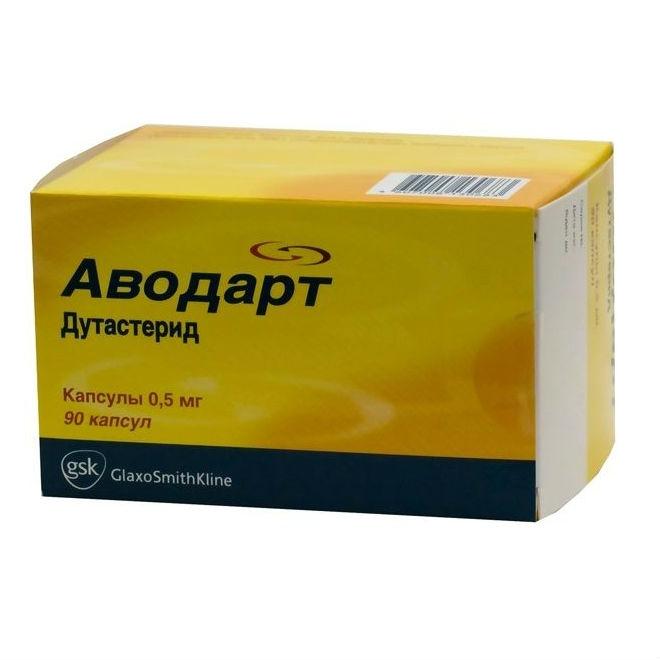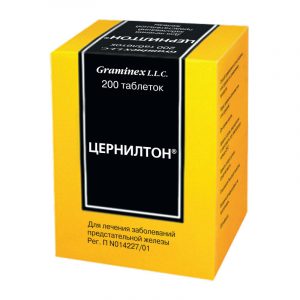Description
Release form
Capsules.
Packing
90 pcs. 50 mcg.
Pharmacological action
A drug for the treatment of benign prostatic hyperplasia.
Dutasteride is a double 5α-reductase inhibitor. It inhibits the activity of 5-reductase isoenzymes of types 1 and 2, which are responsible for the conversion of testosterone to 5-dihydrotestosterone (DHT). Dihydrotestosterone is the main androgen responsible for prostatic gland hyperplasia.
The maximum effect of dutasteride on lowering the concentration of DHT is dose-dependent and is observed 1-2 weeks after the start of treatment.
After 1 and 2 weeks of taking dutasteride at a dose of 500 mcg / day, the average serum dihydrotestosterone concentrations are reduced by 85% and 90%.
Contraindications
Hypersensitivity to dutasteride and other components of the drug.
Hypersensitivity to other 5 -reductase inhibitors.
Avodart ® is contraindicated in women and children.
Caution: the drug should be prescribed for liver failure.
Pregnancy and lactation
Effect on fertility: the effect of dutasteride in a daily dose of 500 μg on sperm characteristics was studied in healthy volunteers aged 18-52 years.
By the 52nd week of treatment, the average values of the percentage reduction in the total sperm count, sperm volume, and sperm motility were 23%, 26%, and 18%, respectively, compared to the baseline. The concentration of sperm and their morphological characteristics did not change.
After 24 weeks of observation, the average percentage change in the total sperm count in the dutasteride group remained 23% lower than the baseline.
The average value for all sperm parameters at all time points remained within the normal range and did not meet the criteria for a clinically significant change (30%), at the 52nd week of treatment, in two volunteers in the dutasteride group, the total sperm count decreased by more than 90% compared to the initial level, with partial recovery at the 24th week of observation. Thus, the clinical significance of the effect of dutasteride on sperm counts and on the individual fertility of the patient is unknown.
Pregnancy: Dutasteride is contraindicated in women. Dutasteride has not been studied in women since preclinical data indicate that suppression of the level of DHT can inhibit the development of the external genitalia in the fetus.
Lactation: There is no data on the penetration of dutasteride into breast milk.
Special instructions
Dutasteride is absorbed through the skin, so women and children should avoid contact with damaged capsules. In case of contact with damaged capsules, immediately wash the corresponding skin area with soap and water.
Impaired liver function
There is currently no data on the use of Avodart ® in patients with impaired liver function. Since dutasteride undergoes intensive metabolism, and its half-life is 3-5 weeks, care must be taken when treating patients with impaired liver function with Avodart ®.
Heart failure with the combined use of dutasteride and tamsulosin
In two 4-year clinical trials, the incidence of heart failure was higher in patients receiving a combination of dutasteride and alpha1-blocker, mainly tamsulosin, than in patients not receiving combined treatment. In these two studies, the incidence of heart failure remained low ( 1%) with some variability between them. But in general, there were no discrepancies in the frequency of side effects from the cardiovascular system. A causal relationship between treatment with dutasteride (as monotherapy or as a combination with alpha1-blocker) and the development of heart failure has not been established.
Effect on the detection of prostate-specific antigen (PSA) and prostate cancer (PCa)
In patients, it is necessary to conduct a digital rectal examination, as well as use other methods for examining the prostate, before treatment with dutasteride and periodically repeat them during treatment to exclude development Prostate cancer.
Determining serum PSA concentration is an important component of screening for PCa. After a 6-month treatment with dutasteride, the average serum PSA level decreases by about 50%. Patients taking dutasteride should be given a new baseline PSA level after 6 months of therapy. In the future, it is recommended to regularly monitor the level of PSA.
The use of dutasteride does not affect the diagnostic value of PSA levels as a marker of prostate cancer. Any confirmed increase in PSA level relative to its lowest value in the treatment with dutasteride may indicate the development of prostate cancer (in particular, prostate cancer with a high degree of differentiation according to the Gleason score) or non-compliance with the dutasteride therapy regimen and should be carefully evaluated, even if these PSA levels remain in within normal values ² ¹ ² ¹for this age category of patients not taking 5 -reductase inhibitors.
Total PSA returns to baseline within 6 months after dutasteride withdrawal.
The ratio of free PSA to total remains constant even with dutasteride therapy. If the determination of the percentage of PSA free fraction is additionally used to detect PCa in men receiving dutasteride, correction of this value is not required.
Effect of long-term dutasteride administration on the development of breast cancer in men
No effect of long-term administration of dutasteride on the development of breast cancer in men.
prostate cancer and high-grade tumors
A 4-year study (REDUCE) compared placebo and dutasteride in 8,231 volunteers aged 50 to 75 years old with a negative biopsy for prostate cancer and a PSA level of 2, 5 ng / ml to 10 ng / ml during the initial examination.
During the study, 6706 patients underwent a puncture biopsy of the prostate gland and on the basis of the obtained results, the degree of malignancy of the prostate cancer was determined according to the Gleason score. 1517 patients were diagnosed with prostate cancer during the study. In most cases, both in the dutasteride group and in the placebo group, a highly differentiated prostate cancer was diagnosed (the total score on the Gleason score is 5-6). There were no differences in the number of cases of prostate cancer with an assessment of 7-10 points on the Gleason score in the dutasteride group and placebo group (p = 0.81).
After 4 years, there were more cases of prostate cancer with an assessment of 8-10 points on the Gleason score in the dutasteride group (n = 29 0.9%) compared with the placebo group (n = 19 0.6%) (p = 0.15 ) When assessing biopsy data for 1-2 years, the number of patients diagnosed with prostate cancer with an assessment of 8-10 points on the Gleason score was comparable in the groups of dutasteride (n = 17 0.5%) and placebo (n = 18 0.5%). When assessing biopsy data for 3-4 years, more cases of prostate cancer were diagnosed with an assessment of 8-10 points on the Gleason score in the dutasteride group (n = 12 0.5%) compared with the placebo group (n = 1 <0.1%) (p = 0.0035). The percentage of patients diagnosed with prostate cancer with an assessment of 8-10 points on the Gleason score was stable for all time periods (for a period of 1-2 and 3-4 years) in the dutasteride group (0.5% in each period), while as in the placebo group, the percentage of patients diagnosed with prostate cancer with an assessment of 8-10 points was lower for 3-4 years than in 1-2 years (<0.1% compared with 0.5%, respectively). In a 4-year study (CombAT) of patients with BPH, in which a biopsy of the prostate was not determined for all participants by protocol, and all diagnoses of prostate cancer were based on indicative biopsy, a prostate cancer with a score of 8-10 on the Gleason score was diagnosed in 8 patients (<0.5%) when taking dutasteride, 11 patients (<0.7%) when taking tamsulosin, and 5 patients (<0.3%) with combination therapy with dutasteride and tamsulosin. A causal relationship between dutasteride intake and the development of high grade PCa has not been established. Men taking dutasteride should be tested regularly for risk assessment of PCa, including PSA levels. Influence on the ability to drive vehicles and operate machinery Taking dutasteride does not affect car driving or working with machinery. Composition 1 capsule contains: Active substance: 500 dutasteride. Excipients: Caprylic / capric acid mono- and diglycerides – 349.5 mg Butylhydroxytoluene – 35 mcg. Capsule shell composition: Gelatin – 144.8 mg Glycerol – 70.8 mg Titanium dioxide – 1.78 mg Iron oxide yellow – 127 mcg Medium chain triglycerides – qs Lecithin – qs srdlk – qs Dosage and administration of The drug can be taken without regard to meals. Capsules should be swallowed whole, not chewed or opened, as the contents of the capsule may cause irritation of the mucous membrane of the oropharynx. Benign prostatic hyperplasia (BPH) Adult men (including the elderly) the recommended dose of Avodart ® is 1 capsule (500 mcg) 1 time / day. Capsules should be taken whole. Although improvement with the use of the drug occurs fairly quickly, treatment should be continued for at least 6 months in order to objectively evaluate the therapeutic effect. For the treatment of BPH, Avodart ® can be prescribed as monotherapy or in combination with alpha1-blockers. Special patient groups Less than 0.1% of the dose is excreted through the kidneys when taking 500 mcg / day, so there is no need to reduce the dose in patients with impaired renal function. There is currently no data on the use of Avodart ® in patients with impaired liver function. Since dutasteride undergoes intensive metabolism, and its half-life is 3-5 weeks, care must be taken when treating patients with impaired liver function with Avodart ®. Side effects Adverse events are listed below, depending on the anatomical and physiological classification and frequency of occurrence. The frequency of occurrence is determined as follows: Very often (? 1/10). Often (? 1/100 and <1/10). Infrequently (? 1/1000 and <1/100). Rarely (? 1/10 000 and <1/1000). Very rare (<1/10 000, including isolated cases). Frequency categories were derived from clinical studies of the drug and post-registration observation. The frequency of occurrence of adverse events, formed on the basis of post-registration observation. On the part of the immune system: very rarely – allergic reactions (including rash, itching, urticaria, localized edema) and angioedema. From the skin and subcutaneous fat: rarely – alopecia (mainly loss of body hair) or hypertrichosis. Mental disorder: very rarely – a depressive state. From the reproductive system: very rarely – testicular pain, testicular edema. Drug Interactions In vitro dutasteride is metabolized by the cytochrome P450 enzyme isoenzyme CYP3A4. In the presence of CYP3A4 inhibitors, blood dutasteride concentrations may increase. With the simultaneous use of dutasteride with CYP3A4 inhibitors verapamil and diltiazem, a decrease in the clearance of dutasteride is noted. However, amlodipine, another calcium channel blocker, does not reduce the clearance of dutasteride. A decrease in the clearance of dutasteride and a subsequent increase in its concentration in the blood with the simultaneous use of this drug and CYP3A4 inhibitors is not significant due to the wide range of safety limits of dutasteride, so there is no need to reduce its dose. In vitro dutasteride is not metabolized by the following isoenzymes of the human cytochrome P450 system: CYP1A2, CYP2A6, CYP2E1, CYP2C8, CYP2C9, CYP2C19 and CYP2D6. Dutasteride does not inhibit in vitro human cytochrome P450 system enzymes involved in drug metabolism. In vitro, dutasteride does not displace warfarin, acenocoumarol, fenprocoumon, diazepam and phenytoin from the sites of their binding to plasma proteins, and these drugs, in turn, do not displace dutasteride. When conducting studies on the interaction of dutasteride with tamsulosin, terazosin, warfarin, digoxin and colestyramine in humans, no clinically significant pharmacokinetic or pharmacodynamic interactions were noted. When using dutasteride simultaneously with lipid-lowering drugs, ACE inhibitors, beta-blockers, calcium channel blockers, corticosteroids, diuretics, NSAIDs, type 5 phosphodiesterase inhibitors and quinolone antibiotics, no significant undesirable drug interactions were observed. overdose Symptoms: Dutasteride up to 40 mg / day once (80 times higher than the therapeutic dose) was not observed within 7 days of significant adverse effects. In clinical trials, patients received dutasteride at a dose of 5 mg daily for 6 months, with no additional adverse effects observed on the background of 500 μg of dutasteride. Treatment: There is no specific antidote to dutasteride, so it is sufficient to carry out symptomatic and supportive treatment in case of overdose. Storage conditions Keep out of the reach and sight of children at temperatures not exceeding 30 ° C. Shelf life 4 years. Prescription conditions from pharmacies Prescription dosage form capsules Appointment Appointment Adults doctor’s prescription GlaxoSmithKline, Poland




